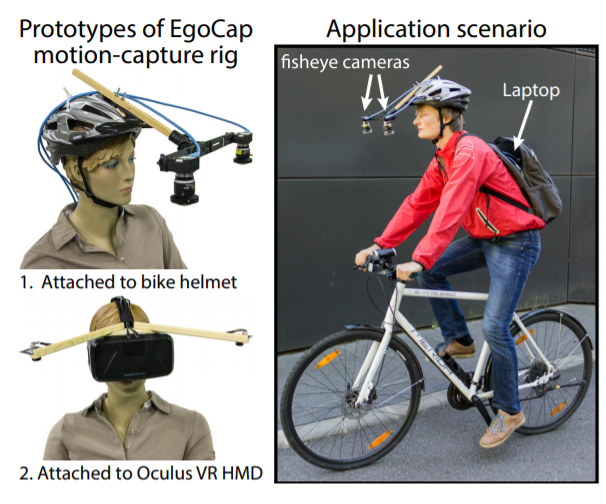EgoCap: Egocentric Marker-less Motion Capture with Two Fisheye Cameras
PubDate: Sep 2016
Teams: Max Planck Institute for Informatics;Intel Visual Computing Institute;University of Bath
Writers: Helge Rhodin, Christian Richardt, Dan Casas, Eldar Insafutdinov, Mohammad Shafiei, Hans-Peter Seidel, Bernt Schiele, Christian Theobalt
PDF: EgoCap: Egocentric Marker-less Motion Capture with Two Fisheye Cameras

Abstract
Marker-based and marker-less optical skeletal motion-capture methods use an outside-in arrangement of cameras placed around a scene, with viewpoints converging on the center. They often create discomfort by possibly needed marker suits, and their recording volume is severely restricted and often constrained to indoor scenes with controlled backgrounds. Alternative suit-based systems use several inertial measurement units or an exoskeleton to capture motion. This makes capturing independent of a confined volume, but requires substantial, often constraining, and hard to set up body instrumentation. We therefore propose a new method for real-time, marker-less and egocentric motion capture which estimates the full-body skeleton pose from a lightweight stereo pair of fisheye cameras that are attached to a helmet or virtual reality headset. It combines the strength of a new generative pose estimation framework for fisheye views with a ConvNet-based body-part detector trained on a large new dataset. Our inside-in method captures full-body motion in general indoor and outdoor scenes, and also crowded scenes with many people in close vicinity. The captured user can freely move around, which enables reconstruction of larger-scale activities and is particularly useful in virtual reality to freely roam and interact, while seeing the fully motion-captured virtual body.
